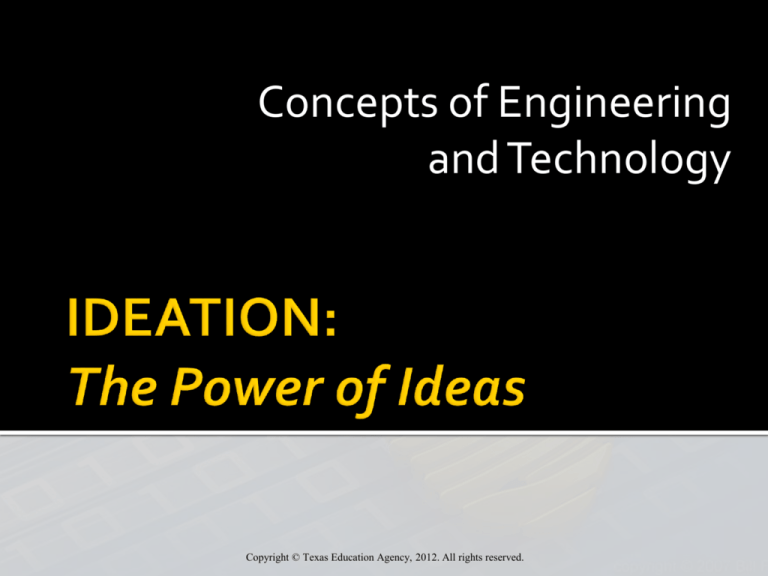
Concepts of Engineering
and Technology
Copyright © Texas Education Agency, 2012. All rights reserved.
The process of forming ideas.
The creative process of generating,
developing, and communicating new ideas
An idea is understood to be a basic
element of thought that can be either
visual, concrete, or abstract
An essential part of the design process,
both in education and practice
Copyright © Texas Education Agency, 2012. All rights reserved.
The exchange of ideas in order to
generate more ideas
To get people to think about things in new ways
It is important to be open and not rule anything
out
No criticism or judgments allowed
Failure is an opportunity to seek new solutions or
ask different questions
Copyright © Texas Education Agency, 2012. All rights reserved.
Improvement is incremental
Innovation is a game changer
Examples of improvement:
Realplayer, Windows media player, winamp
Examples of innovation: ITunes
Netflix is doing to TV what ITunes did to music
Improvement is necessary for a companies
survival, innovation can create market
dominance
Copyright © Texas Education Agency, 2012. All rights reserved.
To create business value. This can be a
reduction in cost, a new product, an
improvement to an existing product, or a new
service
To generate as many ideas as possible in as
condensed a timeframe as possible
Companies want to believe that generating
and leveraging the ideas of their workers is
one of their core competencies and leads to a
competitive advantage
Copyright © Texas Education Agency, 2012. All rights reserved.
To discover important new products or
features
To add efficiency to a process
To develop open communication through the
process of discussion
To leverage the collective brainpower of the
entire organization
People involved develop a sense of purpose and
value to the company
Copyright © Texas Education Agency, 2012. All rights reserved.
Ideation is becoming more common in a
company’s product development process
The old process was more linear and relied on
the capabilities of fewer individuals
The ideation process promotes an internal
corporate culture of trust and shared
information
Anyone can contribute to innovation
Copyright © Texas Education Agency, 2012. All rights reserved.
More than one person, group, or
organizational unit
Collaboration has to be developed
What can we do together must turn into what will
we do together.
Relationships are often the key
There must be some structure to the
process
A tangible goal has to be defined
Copyright © Texas Education Agency, 2012. All rights reserved.
Look at trends
Do an industry analysis
Leverage customer interactions
Voice of the Customer
Customers can provide some insight into wants or
needs
Particularly with early adopters
Brainstorm possible solutions
SWOT analysis (strength, weakness,
opportunities, threats)
Copyright © Texas Education Agency, 2012. All rights reserved.
Creativity
Problems often have contradictory
requirements
Keep the cost down and make it durable
Called an inventive problem
A problem with no known solution
Copyright © Texas Education Agency, 2012. All rights reserved.
Innovation
A new method, idea, or device
Development
To process of producing a product or
result
Actualization
Making the product real
Copyright © Texas Education Agency, 2012. All rights reserved.
Engineers generally think of themselves as
expert problem solvers
Engineers can apply knowledge of systems,
mechanical properties, and have a tool chest of
things that have worked in other situations
Engineers are not generally considered to be
artistic or creative
The tools an engineer uses to solve a problem are
usually analytical or mathematical (logical)
Copyright © Texas Education Agency, 2012. All rights reserved.
Engineering is RESULT driven and the primary
goal is always the same: Find the OPTIMAL
solution to a problem
An engineer want to look at a solution as a
series of simple pieces
Complexity leads to the use of simplifying
assumptions
An outside viewpoint is often needed to
bypass the restrictions that logical or
sequential thinking involves
Copyright © Texas Education Agency, 2012. All rights reserved.
Ideation is a creative process, not an
analytical process
Ideate with a geek, validate with the meek
Diversity is important
You need divergent thinking
not ideas for slight variations to existing products
that do not lead to innovation
Cross functional planning teams
Copyright © Texas Education Agency, 2012. All rights reserved.
Creative problem solving usually
requires two distinct phases: divergent
thinking (ideation) and convergent
thinking (idea analysis and evaluation)
There has to be some method of
implementing proposed solutions
What good are ideas if they are not put to use?
Copyright © Texas Education Agency, 2012. All rights reserved.







